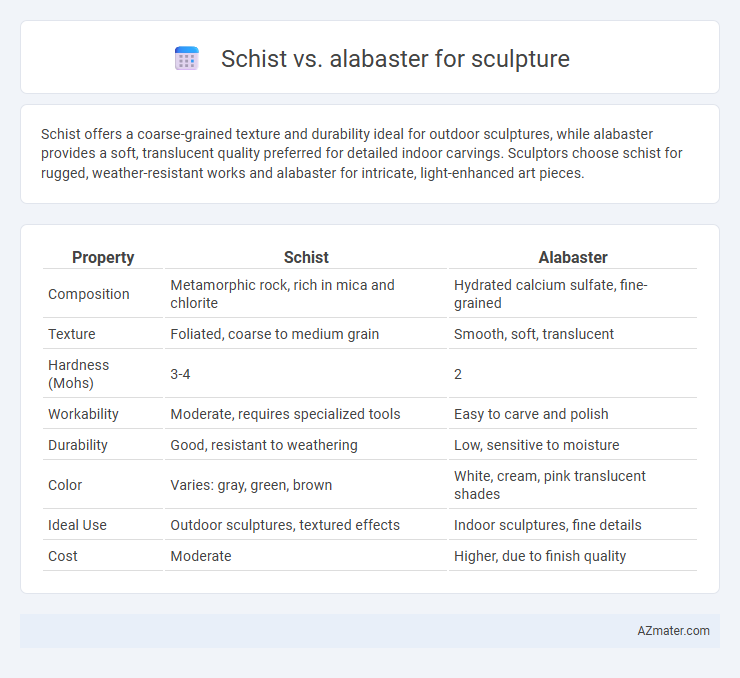Schist offers a coarse-grained texture and durability ideal for outdoor sculptures, while alabaster provides a soft, translucent quality preferred for detailed indoor carvings. Sculptors choose schist for rugged, weather-resistant works and alabaster for intricate, light-enhanced art pieces.
Table of Comparison
| Property | Schist | Alabaster |
|---|---|---|
| Composition | Metamorphic rock, rich in mica and chlorite | Hydrated calcium sulfate, fine-grained |
| Texture | Foliated, coarse to medium grain | Smooth, soft, translucent |
| Hardness (Mohs) | 3-4 | 2 |
| Workability | Moderate, requires specialized tools | Easy to carve and polish |
| Durability | Good, resistant to weathering | Low, sensitive to moisture |
| Color | Varies: gray, green, brown | White, cream, pink translucent shades |
| Ideal Use | Outdoor sculptures, textured effects | Indoor sculptures, fine details |
| Cost | Moderate | Higher, due to finish quality |
Introduction to Schist and Alabaster
Schist is a medium-grade metamorphic rock known for its foliated texture and mineral composition, often rich in mica, which gives it a shimmering appearance and moderate hardness for sculpting. Alabaster is a fine-grained, translucent variety of gypsum or calcite, prized for its softness and smooth surface that allows detailed carving and polish. Both materials offer distinct aesthetic and tactile qualities, making them popular choices for different sculptural styles and techniques.
Geological Origins and Formation
Schist is a metamorphic rock formed through the intense heat and pressure of regional metamorphism acting on shale or mudstone, resulting in a foliated texture rich in mica minerals. Alabaster, on the other hand, is a fine-grained, banded variety of gypsum or calcite formed through the evaporation of ancient marine or lake waters, typically in sedimentary environments. The distinct geological origins influence their texture and workability, with schist's layered structure contrasting the smooth, soft, and homogeneous composition of alabaster favored by sculptors.
Physical Properties Compared
Schist exhibits a foliated, coarse-grained texture with a high sheen due to its mica minerals, making it moderately durable but less ideal for fine detail in sculpture. Alabaster, a soft, fine-grained gypsum or calcite, offers excellent workability and smooth finish, favored for intricate carvings but is more prone to scratching and weathering. The difference in hardness, with schist ranging around 3-4 on Mohs scale and alabaster about 2, significantly influences their longevity and suitability for various sculptural applications.
Workability and Carving Techniques
Schist offers a coarse texture with moderate hardness, requiring robust tools and techniques such as chiseling and hammering for effective carving, making it ideal for detailed relief work and architectural sculptures. Alabaster, known for its soft, fine-grained structure, allows for easier, more precise carving using finer tools like rasps and files, producing smooth, translucent finishes that enhance intricate designs. The choice between schist and alabaster depends on the desired sculptural effect and the level of detail; schist excels in durability and texture, while alabaster emphasizes finesse and polish.
Color and Aesthetic Qualities
Schist features a foliated texture with a range of earthy tones such as grays, greens, and browns, offering a rugged and natural aesthetic for sculpture. Alabaster presents a smooth, translucent surface with creamy whites and soft, warm hues, creating a delicate and luminous visual appeal. The color variation in schist emphasizes its organic, layered structure, while alabaster's uniformity and light-diffusing properties enhance fine details and graceful forms.
Durability and Longevity
Schist offers superior durability and weather resistance compared to alabaster, making it a preferred choice for outdoor sculptures exposed to harsh environmental conditions. Alabaster, being softer and more porous, is prone to erosion and damage over time, particularly when exposed to moisture and physical impact. Sculptors seeking longevity in their works often favor schist for its robust structural properties and low maintenance requirements.
Suitability for Fine Detailing
Schist's coarse-grained texture and natural foliation make it less ideal for fine detailing in sculpture, as its layered structure can cause uneven carving and breakage. Alabaster, composed primarily of gypsum, offers a smooth, uniform surface that allows artists to achieve intricate, delicate details with precision. Sculptors favor alabaster for fine detailing due to its softness and translucency, which also enhances the depth and subtlety of carved features.
Historical and Cultural Uses
Schist has been historically favored in sculpture for its durability and layered texture, commonly used in ancient Egyptian and Mesopotamian art to create statues and reliefs. Alabaster, prized for its translucency and softness, was widely employed in classical Greek and Roman sculptures, as well as in Egyptian funerary masks and religious artifacts to convey purity and divine beauty. Both materials hold significant cultural value; schist represents longevity and resilience, while alabaster symbolizes fragility and spiritual elegance in artistic traditions.
Cost and Availability
Schist is generally more affordable and widely available than alabaster, making it a popular choice for sculptors seeking budget-friendly materials. Alabaster, prized for its smooth texture and translucency, tends to be more expensive and is less commonly sourced, often requiring specialized suppliers. The cost difference arises from alabaster's delicate mining process and limited geographic occurrence compared to the more abundant schist deposits.
Choosing the Right Stone for Sculpture
Schist offers a durable, coarse-grained texture ideal for sculptures requiring structural strength and detailed carving, making it suitable for outdoor or large-scale works. Alabaster boasts a soft, translucent quality that enhances fine, delicate details with a smooth finish, favored for indoor sculptures and intricate designs. Selecting between schist and alabaster depends on the desired sculpture durability, scale, texture, and light interaction properties.

Infographic: Schist vs Alabaster for Sculpture
 azmater.com
azmater.com